Uncovering Impacts of Tourism on Social–Ecological Vulnerability Using Geospatial Analysis and Big Earth Data: A Karst Ethnic Village Perspective
Abstract
1. Introduction
2. Materials and Methods
2.1. Study Area
2.2. Data Sources
2.3. Methods
2.3.1. Development of Index System
2.3.2. Weight Calculation of Evaluation Index
- Positive indices:
- Negative indices:
2.3.3. Comprehensive Evaluation Model
2.3.4. Spatially Explicit Resilience–Vulnerability (SERV) Model
2.3.5. Spatial Autocorrelation
2.3.6. Geographic Detector
3. Results
3.1. SV Index and Its Spatial Distribution
3.2. EV Index and Its Spatial Distribution
3.3. Independent Effects of Factors on Vulnerability
3.4. Effect of Factor Interactions on Vulnerability
4. Discussions
4.1. Mechanism of Action
4.2. Policy Recommendations
5. Conclusions
Author Contributions
Funding
Data Availability Statement
Conflicts of Interest
References
- Huang, C.; Xu, N. Quantifying urban expansion from 1985 to 2018 in large cities worldwide. Geocarto Int. 2022, 37, 18356–18371. [Google Scholar] [CrossRef]
- Huang, C.; Tang, Y.; Wu, Y.; Tao, Y.; Xu, M.; Xu, N.; Li, M.; Liu, X.; Xi, H.; Ou, W. Assessing Long-Term Thermal Environment Change with Landsat Time-Series Data in a Rapidly Urbanizing City in China. Land 2024, 13, 177. [Google Scholar] [CrossRef]
- Ou, Y.; Zheng, J.; Liang, Y.; Bao, Z. When green transportation backfires: High-speed rail’s impact on transport-sector carbon emissions from 315 Chinese cities. Sustain. Cities Soc. 2024, 114, 105770. [Google Scholar] [CrossRef]
- D’Ettorre, U.S.; Liso, I.S.; Parise, M. Desertification in karst areas: A review. Earth-Sci. Rev. 2024, 253, 104786. [Google Scholar] [CrossRef]
- Vilhar, U.; Kermavnar, J.; Kozamernik, E.; Petrič, M.; Ravbar, N. The effects of large-scale forest disturbances on hydrology—An overview with special emphasis on karst aquifer systems. Earth-Sci. Rev. 2022, 235, 104243. [Google Scholar] [CrossRef]
- Zhang, M.; Chen, E.; Zhang, C.; Liu, C.; Li, J. Multi-Scenario Simulation of Land Use Change and Ecosystem Service Value Based on the Markov–FLUS Model in Ezhou City, China. Sustainability 2024, 16, 6237. [Google Scholar] [CrossRef]
- Kwak, Y.; Chen, S. Integrating seasonal climate variability and spatial accessibility in ecosystem service value assessment for optimized NbS allocation. Urban Clim. 2025, 59, 102314. [Google Scholar] [CrossRef]
- Kates, R.W.; Clark, W.C.; Corell, R.; Hall, J.M.; Jaeger, C.C.; Lowe, I.; McCarthy, J.J.; Schellnhuber, H.J.; Bolin, B.; Dickson, N.M.; et al. Environment and development. Sustainability science. Science 2001, 292, 641–642. [Google Scholar] [CrossRef]
- Turner, B.L.; Kasperson, R.E.; Matson, P.A.; McCarthy, J.J.; Corell, R.W.; Christensen, L.; Eckley, N.; Kasperson, J.X.; Luers, A.; Martello, M.L.; et al. A framework for vulnerability analysis in sustainability science. Proc. Natl. Acad. Sci. USA 2003, 100, 8074–8079. [Google Scholar] [CrossRef]
- Huang, C.; Xu, N. Climatic factors dominate the spatial patterns of urban green space coverage in the contiguous United States. Int. J. Appl. Earth Obs. Geoinf. 2022, 107, 102691. [Google Scholar] [CrossRef]
- Huang, X.; He, J.; Zhang, Q.; Wu, Z.; Wu, Y. Evaluating wetland ecosystem services value and dominant functions: Insights from the Pearl River Delta. J. Environ. Manag. 2024, 371, 123069. [Google Scholar] [CrossRef] [PubMed]
- Huang, Z.; Huang, R. Research on Rural Culture under the Background of Urbanization and Tourism Development: Academic Controversy and Research Directions. Geogr. Res. 2018, 37, 233–249. [Google Scholar]
- Ma, D.Y.; Zhang, C. Study of the Main Social Problems of Tourism Development in Ethnic Villages. In Proceedings of the 2017 6th International Conference on Energy and Environmental Protection (ICEEP 2017), Zhuhai, China, 29–30 June 2017; pp. 268–271. [Google Scholar]
- Lee, Y.-J. Social vulnerability indicators as a sustainable planning tool. Environ. Impact Assess. Rev. 2014, 44, 31–42. [Google Scholar] [CrossRef]
- Ford, D.; Williams, P. Introduction to Karst. In Karst Hydrogeology and Geomorphology; John Wiley & Sons: Hoboken, NJ, USA, 2007; pp. 1–8. [Google Scholar]
- Van Beynen, P.; Townsend, K. A Disturbance Index for Karst Environments. Environ. Manag. 2005, 36, 101–116. [Google Scholar] [CrossRef]
- Wang, L.; Chen, Q.; Zhou, Z.; Zhao, X.; Luo, J.; Wu, T.; Sun, Y.; Liu, W.; Zhang, S.; Zhang, W. Crops planting structure and karst rocky desertification analysis by Sentinel-1 data. Open Geosci. 2021, 13, 867–879. [Google Scholar] [CrossRef]
- Ma, J.; Li, C.X.; Wei, H.; Ma, P.; Yang, Y.J.; Ren, Q.S.; Zhang, W. Ecological Vulnerability Assessment of Three Gorges Reservoir Area. J. Ecol. 2015, 35, 7117–7129. [Google Scholar]
- García-Sánchez, I.-M.; Almeida, T.A.d.N.; Camara, R.P.d.B. A proposal for a Composite Index of Environmental Performance (CIEP) for countries. Ecol. Indic. 2015, 48, 171–188. [Google Scholar] [CrossRef]
- Burrell, A.L.; Evans, J.P.; De Kauwe, M.G. Anthropogenic climate change has driven over 5 million km2 of drylands towards desertification. Nat. Commun. 2020, 11, 3853. [Google Scholar] [CrossRef]
- UNCCD. Conference of the Parties to the United Nations Convention to Combat Desertification in Those Countries Experiencing Serious Drought and/or Desertification, particularly in Africa (8th sess.: 2007: Madrid). In Report of the Conference of the Parties on its 8th session, held in Madrid from 3 to 14 September 2007; Part 1, Proceedings; UN: Geneva, Switzerland, 2007. [Google Scholar]
- Zhao, D.; Liu, F. Indigenous Forest Knowledge (IFK) and Nature Reserve Workers’ Perceptions of IFK: A Case Study of Leigongshan National Nature Reserve, China. J. Sustain. For. 2022, 41, 721–744. [Google Scholar] [CrossRef]
- Ciacci, A.; Ivaldi, E.; Mangano, S.; Ugolini, G.M. Environment, logistics and infrastructure: The three dimensions of influence of Italian coastal tourism. J. Sustain. Tour. 2023, 31, 1583–1607. [Google Scholar] [CrossRef]
- Okumus, F.; Kocak, E. Tourism and economic output: Do asymmetries matter? Ann. Tour. Res. 2023, 100, 103570. [Google Scholar] [CrossRef]
- Qiu, R.T.R.; Park, J.; Li, S.; Song, H. Social costs of tourism during the COVID-19 pandemic. Ann. Tour. Res. 2020, 84, 102994. [Google Scholar] [CrossRef] [PubMed]
- Khan, A.; Bibi, S.; Lyu, J.; Latif, A.; Lorenzo, A. COVID-19 and sectoral employment trends: Assessing resilience in the US leisure and hospitality industry. Curr. Issues Tour. 2021, 24, 952–969. [Google Scholar] [CrossRef]
- Kanwal, S.; Rasheed, M.I.; Pitafi, A.H.; Pitafi, A.; Ren, M. Road and transport infrastructure development and community support for tourism: The role of perceived benefits, and community satisfaction. Tour. Manag. 2020, 77, 104014. [Google Scholar] [CrossRef]
- Ou, Y.; Zheng, J.; Li, S.; Chen, K.; Bao, Z. High-speed rail development and economic performance: A perspective on urban-rural disparities in the treatment and spillover effects. Res. Transp. Bus. Manag. 2025, 59, 101287. [Google Scholar] [CrossRef]
- Yang, E. Spatiotemporal role of tourism in mitigating social vulnerability. J. Hosp. Tour. Manag. 2024, 60, 291–302. [Google Scholar] [CrossRef]
- Alvarez, S.; Bahja, F.; Fyall, A. A framework to identify destination vulnerability to hazards. Tour. Manag. 2022, 90, 104469. [Google Scholar] [CrossRef]
- Zhao, J.; Li, S. The Impact of Tourism Development on the Environment in China. Acta Sci. Malays. 2018, 2, 1–4. [Google Scholar] [CrossRef]
- Gabor, T.; Griffith, T.K. The assessment of community vulnerability to acute hazardous materials incidents. J. Hazard. Mater. 1980, 3, 323–333. [Google Scholar] [CrossRef]
- Adger, W.N. Vulnerability. Glob. Environ. Change 2006, 16, 268–281. [Google Scholar] [CrossRef]
- De Lange, H.J.; Sala, S.; Vighi, M.; Faber, J.H. Ecological vulnerability in risk assessment—A review and perspectives. Sci. Total Environ. 2010, 408, 3871–3879. [Google Scholar] [CrossRef] [PubMed]
- Ling, H.; Guo, B.; Zhang, G.; Xu, H.; Deng, X. Evaluation of the ecological protective effect of the “large basin” comprehensive management system in the Tarim River basin, China. Sci. Total Environ. 2019, 650, 1696–1706. [Google Scholar] [CrossRef] [PubMed]
- Nguyen, A.K.; Liou, Y.-A.; Li, M.-H.; Tran, T.A. Zoning eco-environmental vulnerability for environmental management and protection. Ecol. Indic. 2016, 69, 100–117. [Google Scholar] [CrossRef]
- Chen, J.; Yang, X.; Yin, S.; Wu, K.; Deng, M.; Wen, X. The vulnerability evolution and simulation of social-ecological systems in a semi-arid area: A case study of Yulin City, China. J. Geogr. Sci. 2018, 28, 152–174. [Google Scholar] [CrossRef]
- Blaikie, P.; Cannon, T.; Davis, I.; Wisner, B. At Risk: Natural Hazards, People’s Vulnerability and Disasters, 2nd ed.; Routledge: Abingdon, UK, 2014. [Google Scholar] [CrossRef]
- Hambling, T.; Weinstein, P.; Slaney, D. A Review of Frameworks for Developing Environmental Health Indicators for Climate Change and Health. Int. J. Environ. Res. Public Health 2011, 8, 2854–2875. [Google Scholar] [CrossRef]
- Zhou, S.; Ye, J.; Li, J.; Zhang, G.; Duan, Y. Identifying intrinsic drivers to changes in riparian ecosystem services by using PSR framework: A case study of the Grand Canal in Jiangsu, China. Environ. Dev. 2022, 43, 100728. [Google Scholar] [CrossRef]
- Beroya-Eitner, M.A. Ecological vulnerability indicators. Ecol. Indic. 2016, 60, 329–334. [Google Scholar] [CrossRef]
- Polsky, C.; Neff, R.; Yarnal, B. Building comparable global change vulnerability assessments: The vulnerability scoping diagram. Glob. Environ. Change 2007, 17, 472–485. [Google Scholar] [CrossRef]
- Chen, J.; Yang, X.J.; Ying, S.; Wu, K.S. Evolution and simulation of social ecosystem vulnerability in semi-arid regions based on VSD framework. Geogr. J. 2016, 71, 1172–1188. [Google Scholar] [CrossRef]
- Marshall, N.A.; Marshall, P.A.; Tamelander, J.; Obura, D.; Malleret-King, D.; Cinner, J.E. A Framework for Social Adaptation to Climate Change: Sustaining Tropical Coastal Communities and Industries; IUCN: Gland, Switzerland, 2010. [Google Scholar]
- Yu, Z.Y.; Li, B.; Zhang, X.S. Analysis of Social Ecological System and Vulnerability Driving Mechanism. J. Ecol. 2014, 34, 1870–1879. [Google Scholar]
- Coluzzi, R.; Bianchini, L.; Egidi, G.; Cudlin, P.; Imbrenda, V.; Salvati, L.; Lanfredi, M. Density matters? Settlement expansion and land degradation in Peri-urban and rural districts of Italy. Environ. Impact Assess. Rev. 2022, 92, 106703. [Google Scholar] [CrossRef]
- Jiang, H.; Yu, Y.; Chen, M.-M.; Huang, W. The climate change vulnerability of China: Spatial evolution and driving factors. Environ. Sci. Pollut. Res. 2021, 28, 39757–39768. [Google Scholar] [CrossRef] [PubMed]
- Guo, B.; Zang, W.; Luo, W. Spatial-temporal shifts of ecological vulnerability of Karst Mountain ecosystem-impacts of global change and anthropogenic interference. Sci. Total Environ. 2020, 741, 140256. [Google Scholar] [CrossRef] [PubMed]
- Wei, J.; Guo, Y.M.; Sun, L.; Jiang, T.; Tian, X.P.; Sun, G.D. Evaluation of ecological environment vulnerability for Sanjiangyuan area. Chin. J. Ecol. 2015, 34, 1968–1975. [Google Scholar]
- Teng, Y.; Zhan, J.; Liu, S.; Agyemanga, F.B.; Li, Z.; Wang, C.; Liu, W. Integrating ecological and social vulnerability assessment in Qinghai Province, China. Phys. Chem. Earth Parts A/B/C 2022, 126, 103115. [Google Scholar] [CrossRef]
- Lu, D.; Shi, Y.; Li, W.; Yang, X. Spatiotemporal change of vulnerability in counties of northwest China. Prog. Geogr. 2017, 36, 404–415. [Google Scholar]
- Zhang, W.; Wen, L. An Examination of the Variables Affecting the Growth of the Tourist Sector in Guizhou Province. Sustainability 2022, 14, 11297. [Google Scholar] [CrossRef]
- Gao, J.; Wu, B. Revitalizing traditional villages through rural tourism: A case study of Yuanjia Village, Shaanxi Province, China. Tour. Manag. 2017, 63, 223–233. [Google Scholar] [CrossRef]
- Wang, H.; Yang, Z.; Chen, L.; Yang, J.; Li, R. Minority community participation in tourism: A case of Kanas Tuva villages in Xinjiang, China. Tour. Manag. 2010, 31, 759–764. [Google Scholar] [CrossRef]
- Zhang, B.; Zhang, R.; Jiang, G.; Cai, W.; Su, K. Improvement in the quality of living environment with mixed land use of rural settlements: A case study of 18 villages in Hebei, China. Appl. Geogr. 2023, 157, 103016. [Google Scholar] [CrossRef]
- Li, R.; Chen, J.; Yang, X.; Yin, S.; Shi, R.; Bai, Y.; Xu, L. The impact of population change on social-ecological systems’ vulnerability: A case of the Qinling-Daba Mountains of Southern Shaanxi in China. J. Clean. Prod. 2024, 476, 143682. [Google Scholar] [CrossRef]
- Sun, Y.; Ou, Q. Research on the traditional zoning, evolution, and integrated conservation of village cultural landscapes based on “production-living-ecology spaces” —A case study of villages in Meicheng, Guangdong, China. Open Geosci. 2021, 13, 1303–1317. [Google Scholar] [CrossRef]
- Yang, W.; Fan, B.; Tan, J.; Lin, J.; Shao, T. The Spatial Perception and Spatial Feature of Rural Cultural Landscape in the Context of Rural Tourism. Sustainability 2022, 14, 4370. [Google Scholar] [CrossRef]
- Tang, C.; Yang, Y.; Liu, Y.; Xiao, X. Comprehensive evaluation of the cultural inheritance level of tourism-oriented traditional villages: The example of Beijing. Tour. Manag. Perspect. 2023, 48, 101166. [Google Scholar] [CrossRef]
- Zhang, Y.; Min, Q.; Zhang, C.; He, L.; Zhang, S.; Yang, L.; Tian, M.; Xiong, Y. Traditional culture as an important power for maintaining agricultural landscapes in cultural heritage sites: A case study of the Hani terraces. J. Cult. Herit. 2016, 25, 170–179. [Google Scholar] [CrossRef]
- Zheng, G.-h.; Jiang, D.-f.; Luan, Y.-f.; Yao, Y. GIS-based spatial differentiation of ethnic minority villages in Guizhou Province, China. J. Mt. Sci. 2022, 19, 987–1000. [Google Scholar] [CrossRef]
- Zhang, Y.; Zhou, D.; Li, Z.; Qi, L. Spatial and temporal dynamics of social-ecological resilience in Nepal from 2000 to 2015. Phys. Chem. Earth Parts A/B/C 2020, 120, 102894. [Google Scholar] [CrossRef]
- Qiu, B.; Li, H.; Zhou, M.; Zhang, L. Vulnerability of ecosystem services provisioning to urbanization: A case of China. Ecol. Indic. 2015, 57, 505–513. [Google Scholar] [CrossRef]
- Yang, W.; Xu, K.; Lian, J.; Ma, C.; Bin, L. Integrated flood vulnerability assessment approach based on TOPSIS and Shannon entropy methods. Ecol. Indic. 2018, 89, 269–280. [Google Scholar] [CrossRef]
- Zhao, J.; Ji, G.; Tian, Y.; Chen, Y.; Wang, Z. Environmental vulnerability assessment for mainland China based on entropy method. Ecol. Indic. 2018, 91, 410–422. [Google Scholar] [CrossRef]
- Li, S.; Wei, H.; Ni, X.; Gu, Y.-W.; Changxiao, L. Evaluation of urban human settlement quality in Ningxia based on AHP and the entropy method. Ying Yong Sheng Tai Xue Bao = J. Appl. Ecol./Zhongguo Sheng Tai Xue Xue Hui Zhongguo Ke Xue Yuan Shenyang Ying Yong Sheng Tai Yan Jiu Suo Zhu Ban 2014, 25, 2700–2708. [Google Scholar]
- Frazier, T.G.; Thompson, C.M.; Dezzani, R.J. A framework for the development of the SERV model: A Spatially Explicit Resilience-Vulnerability model. Appl. Geogr. 2014, 51, 158–172. [Google Scholar] [CrossRef]
- Ou, Y.; Bao, Z.; Ng, S.T.; Song, W.; Chen, K. Land-use carbon emissions and built environment characteristics: A city-level quantitative analysis in emerging economies. Land Use Policy 2024, 137, 107019. [Google Scholar] [CrossRef]
- Cutter, S.L. The origin and diffusion of the social vulnerability index (SoVI). Int. J. Disaster Risk Reduct. 2024, 109, 104576. [Google Scholar] [CrossRef]
- Baloch, Q.B.; Shah, S.N.; Iqbal, N.; Sheeraz, M.; Asadullah, M.; Mahar, S.; Khan, A.U. Impact of tourism development upon environmental sustainability: A suggested framework for sustainable ecotourism. Environ. Sci. Pollut. Res. 2023, 30, 5917–5930. [Google Scholar] [CrossRef]
- Li, L.; Feng, R.; Xi, J.; Huijbens, E.H.; Gao, Y. Distinguishing the impact of tourism development on ecosystem service trade-offs in ecological functional zone. J. Environ. Manag. 2023, 342, 118183. [Google Scholar] [CrossRef]
- Xue, L.; Wang, J.; Zhang, L.; Wei, G.; Zhu, B. Spatiotemporal analysis of ecological vulnerability and management in the Tarim River Basin, China. Sci. Total Environ. 2019, 649, 876–888. [Google Scholar] [CrossRef]
- Zhao, D.; Wu, S. Vulnerability of natural ecosystem in China under regional climate scenarios: An analysis based on eco-geographical regions. J. Geogr. Sci. 2014, 24, 237–248. [Google Scholar] [CrossRef]
- Cheng, Y.; Gao, S.; Li, S.; Zhang, Y.; Rosenberg, M. Understanding the spatial disparities and vulnerability of population aging in China. Asia Pac. Policy Stud. 2018, 6, 73–89. [Google Scholar] [CrossRef]
- Ardoin, N.M.; Bowers, A.W.; Gaillard, E. Environmental education outcomes for conservation: A systematic review. Biol. Conserv. 2020, 241, 108224. [Google Scholar] [CrossRef]
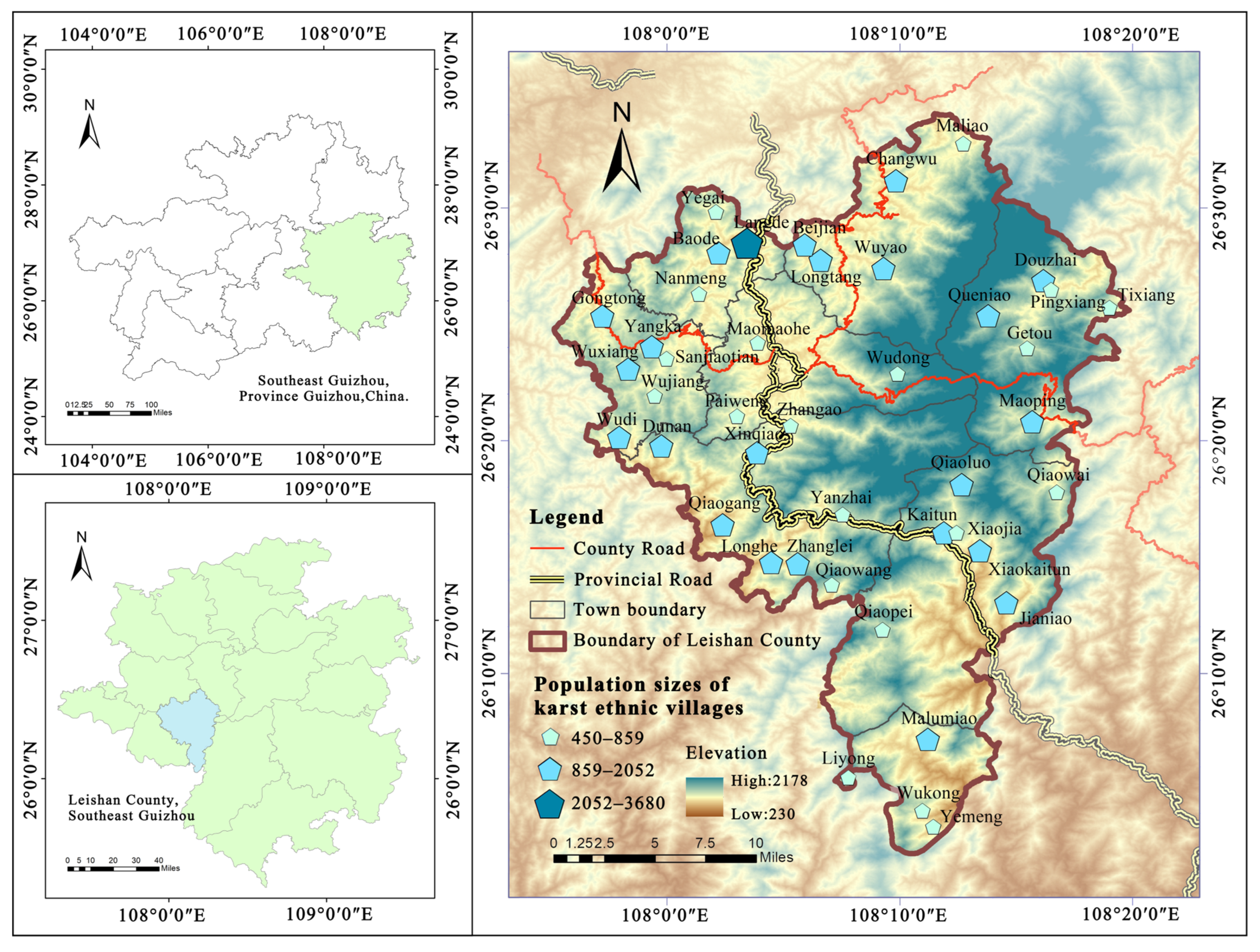


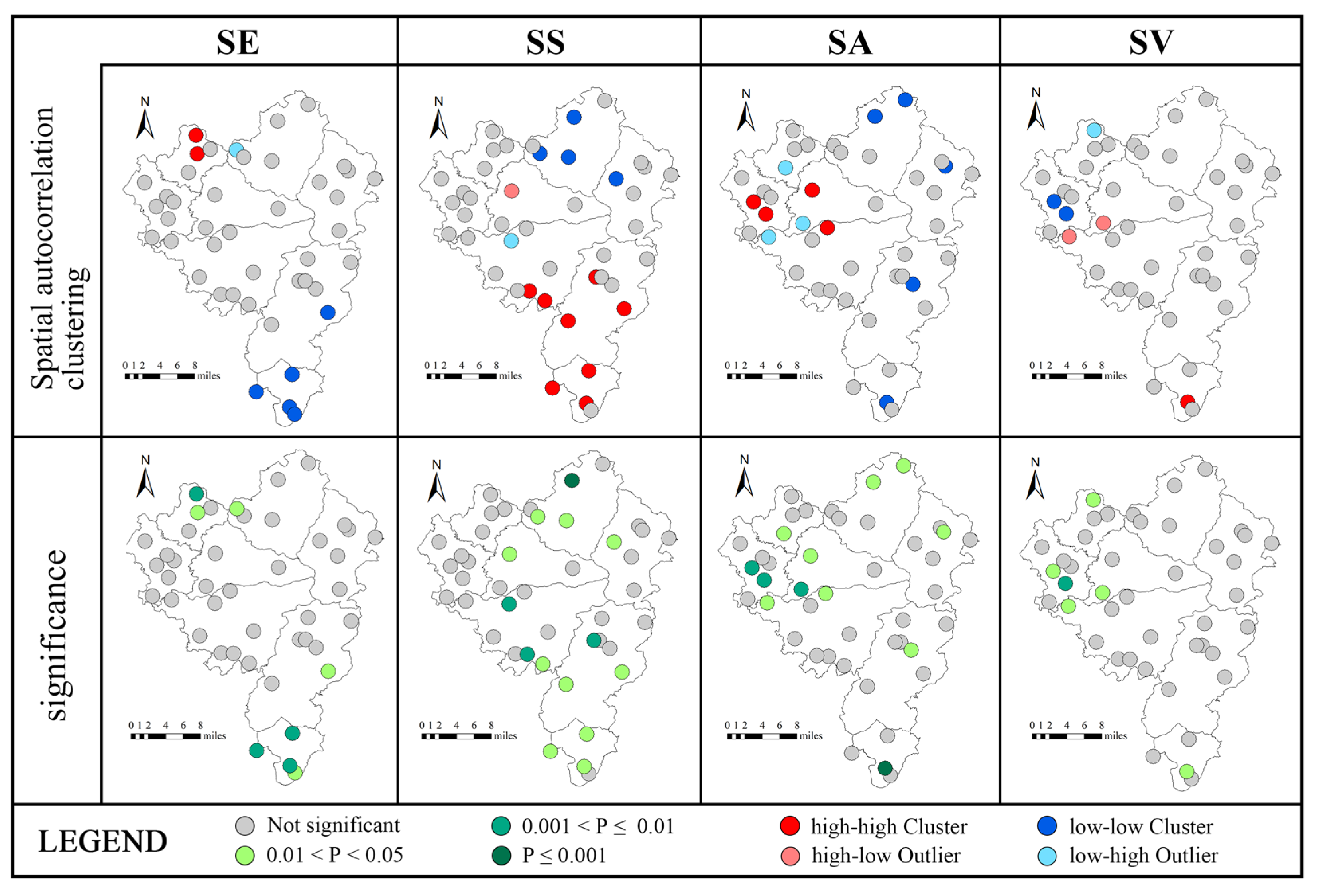
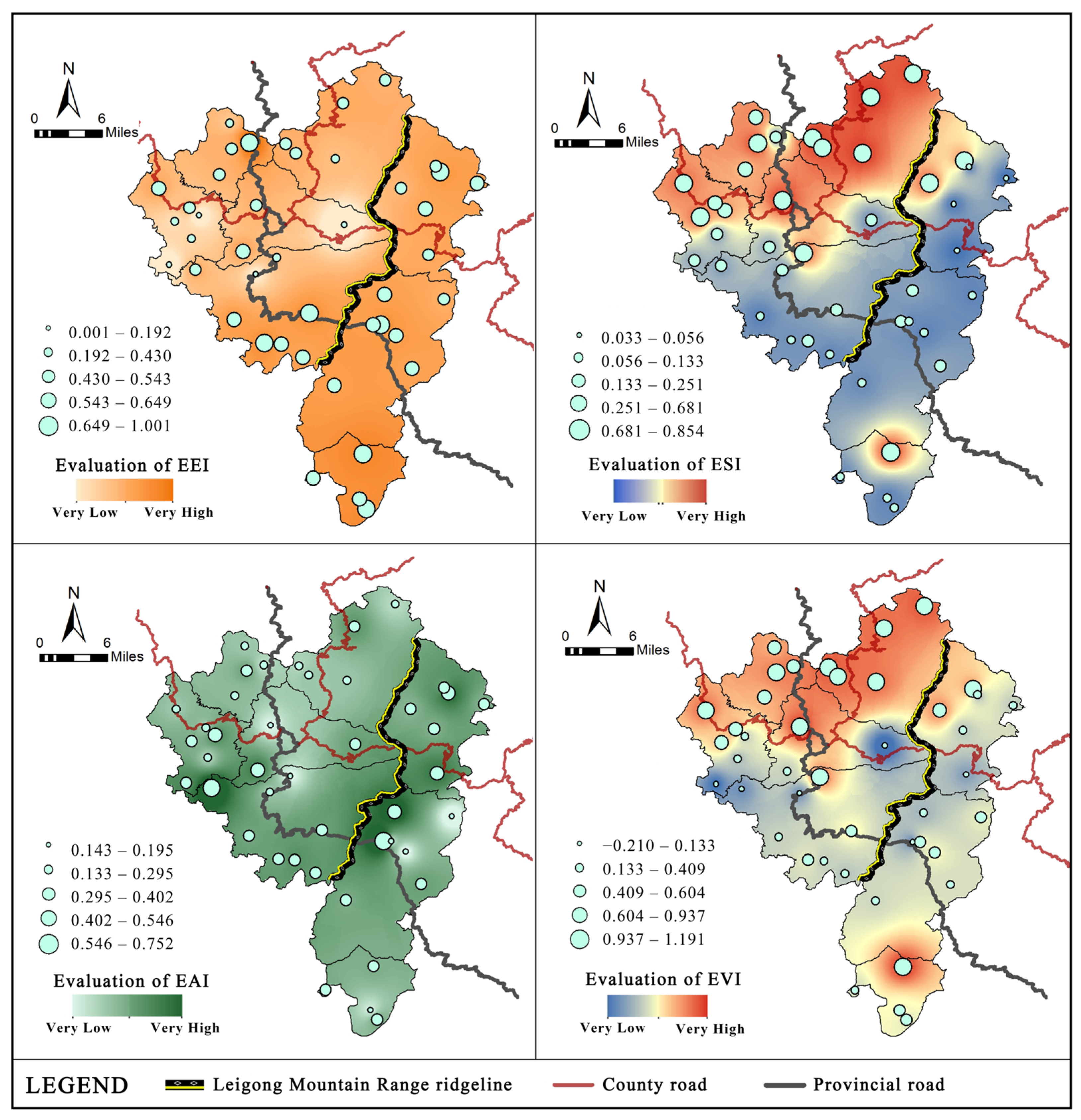
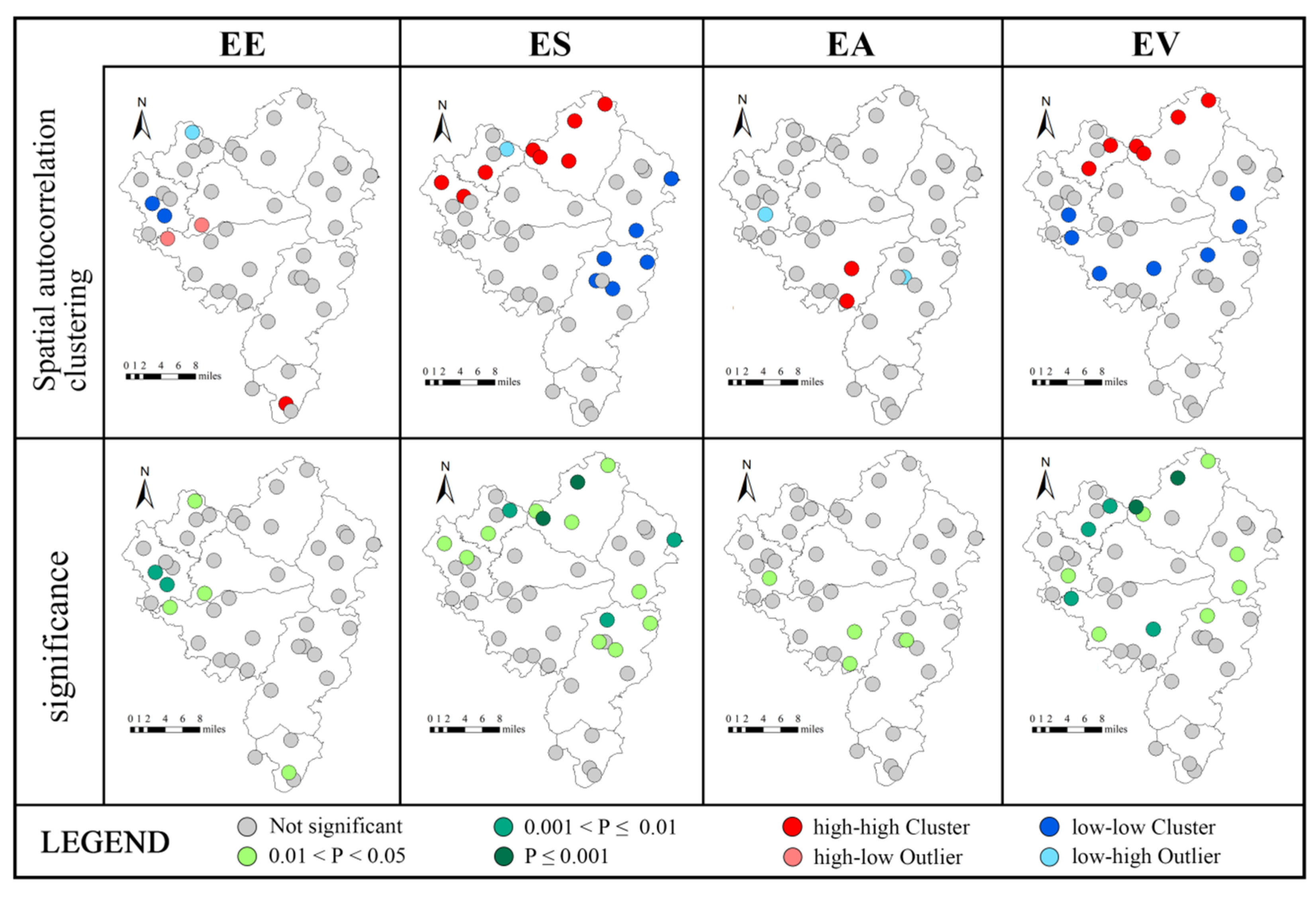

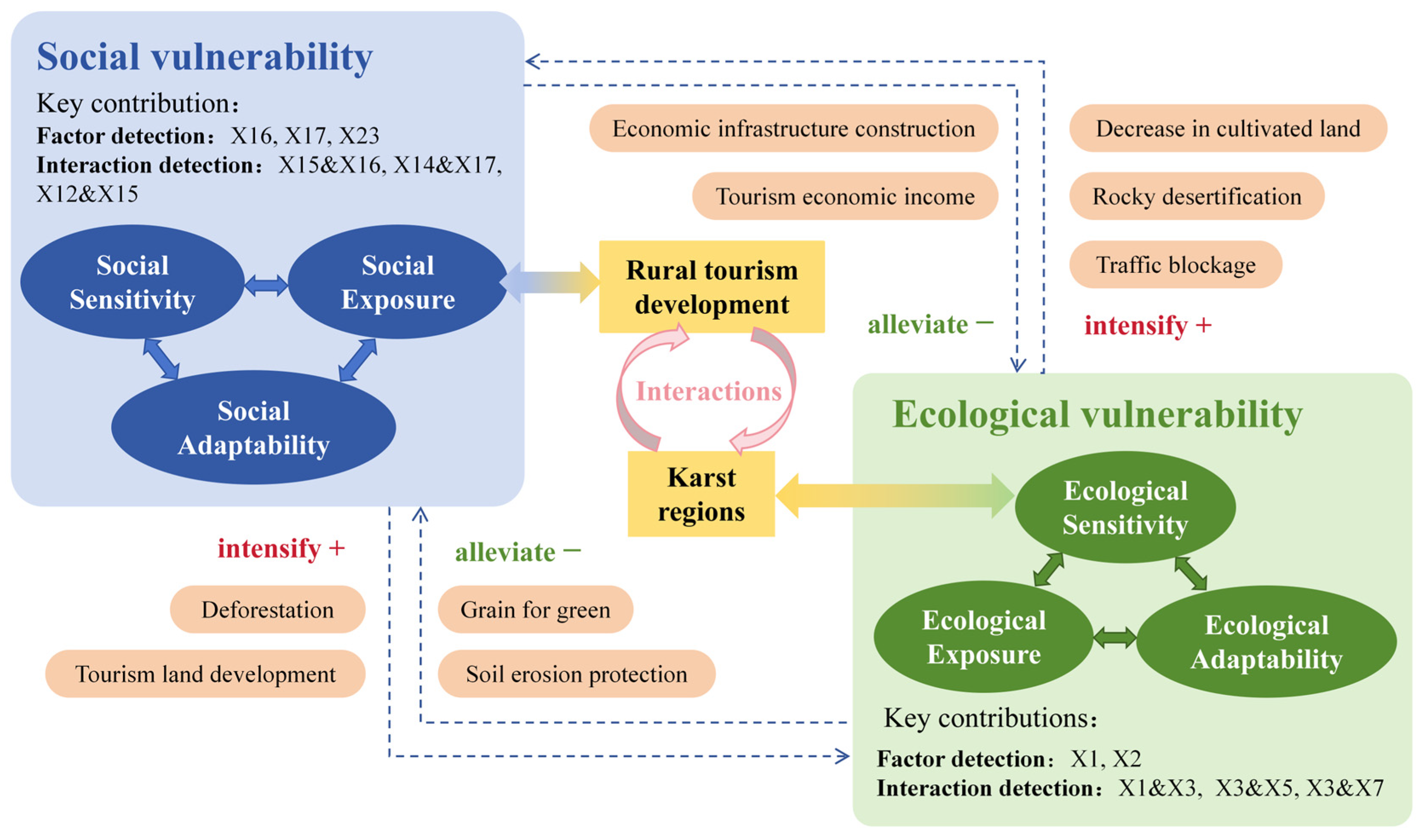
| Raw Data | Data Source | Processing Method | Indicator Collection |
|---|---|---|---|
| Terrain data | Geographic spatial data cloud (https://gscloud.cn/, accessed on September 2023) | Spatial analysis | Slope |
| Meteorological data | Environment, and data platform (https://www.resdc.cn/, accessed on September 2023) | Statistical analysis | Precipitation |
| Land use pattern | Earth Big Data Science Project of the Chinese Academy of Sciences | Spatial analysis | Biological richness index, vegetation coverage rate |
| Statistical yearbook data | National Bureau of Statistics (https://www.stats.gov.cn/, accessed on September 2023) | Statistical analysis | Farmland area, population, and economic indicators |
| Land resources data | National Glacier, Frozen Soil and Desert Science Data Center (https://www.ncdc.ac.cn/portal/, accessed on September 2023) | Spatial analysis | Soil sand content |
| Resident social life data | Traditional Village Protection Plan and Archives and Construction Project List (obtained through offline visits on July 2023) | Statistical analysis | Transportation convenience, tourism revenue, aging population, cultural heritage, industrial diversity, community relations, etc. |
| Target Layer | Dimension Layer | Index Number | Index | Effect Direction | Weight | Reference |
|---|---|---|---|---|---|---|
| Ecological vulnerability | Exposure | X1 | The average value of social vulnerability | + | 0.0390 | [50] |
| Sensitivity | X2 | Slope | + | 0.1184 | [48] | |
| X3 | Degree of rocky desertification (soil sediment content) | + | 0.4572 | [48] | ||
| X4 | Annual precipitation | − | 0.0949 | [48] | ||
| Adaptability | X5 | Forest coverage index (NDVI) | + | 0.0397 | [49] | |
| X6 | Biological richness index | + | 0.0826 | [49] | ||
| X7 | Cultivated area | − | 0.1682 | [51] | ||
| Social vulnerability | Exposure | X8 | Annual average tourist reception volume | + | 0.2728 | [52] |
| X9 | Tourism participation population | + | 0.2344 | [53] | ||
| X10 | Funds for construction | − | 0.0234 | [51] | ||
| X11 | Construction land area | + | 0.0336 | [51] | ||
| X12 | Transportation convenience (distance from the county seat) | + | 0.0100 | [54] | ||
| bb | Sensitivity | X13 | Completeness of public facilities | − | 0.0135 | [55] |
| X14 | Per capita annual household income | + | 0.0205 | [56] | ||
| X15 | Preservation degree of traditional dwellings | + | 0.0156 | [57] | ||
| X16 | Hollow out rate (proportion of migrant workers) | − | 0.0166 | [56] | ||
| X17 | Aging rate | − | 0.0316 | [56] | ||
| X18 | Preservation degree of intangible cultural heritage | − | 0.0034 | [58] | ||
| Adaptability | X19 | Neighborhood relations (number of folk activities) | + | 0.0638 | [59] | |
| X20 | Community learning (traditional skills training) | + | 0.0435 | [60] | ||
| X21 | Disaster response capability (investment funds) | + | 0.1679 | [60] | ||
| X22 | Industrial Diversity Index | + | 0.0320 | [61] | ||
| X23 | Implementation time of protection plan | + | 0.0174 | [57] |
| SEI | SSI | SAI | SVI | |
|---|---|---|---|---|
| Moran’s I | 0.039 | 0.3946 | 0.1832 | 0.1521 |
| Z-Score | 2.0211 | 4.3120 | 2.1638 | 1.9635 |
| p-value | 0.047 | 0.001 | 0.03 | 0.047 |
| Spatial pattern | Clustered | Clustered | Clustered | Clustered |
| EEI | ESI | EAI | EVI | |
|---|---|---|---|---|
| Moran’ s I | 0.152 | 0.4781 | −0.0434 | 0.3826 |
| Z-Score | 1.9635 | 4.7234 | −0.1869 | 3.7180 |
| p-value | 0.047 | 0.001 | 0.463 | 0.001 |
| Spatial pattern | Clustered | Clustered | Not significant | Clustered |
| Driving Factors | q-Value | Driving Factors | q-Value |
|---|---|---|---|
| Annual average tourist reception volume | 0.2116 | Preservation degree of traditional dwellings | 0.6460 |
| Tourism participation population | 0.2520 | Hollow out rate | 0.1042 |
| Funds for construction | 0.2712 | Aging rate | 0.0996 |
| Construction land area | 0.1241 | Preservation degree of intangible cultural heritage | 0.2067 |
| Transportation convenience | 0.3532 | Neighborhood relations | 0.2792 |
| Implementation time of protection plan | 0.3032 | Community learning | 0.0356 |
| Completeness of public facilities | 0.1189 | Disaster response capability | 0.7130 |
| Per capita annual household income | 0.4684 | Industrial diversity index | 0.0622 |
| Driving Factors | q-Value | Driving Factors | q-Value |
|---|---|---|---|
| The average value of social vulnerability | 0.5456 | Forest coverage index (NDVI) | 0.1677 |
| Annual precipitation | 0.1340 | Degree of rocky desertification | 0.6996 |
| Cultivated area | 0.3303 | Biological richness index | 0.2694 |
| Slope | 0.0459 |
| Basis for Judgment | Types of the Interaction |
|---|---|
| q(X1∩X2) < Min(q(X1), q(X2)) | Non-linear attenuation |
| Min(q(X1)), q(X2)) < q(X1∩X2) < Max(q(X1), q(X2)) | Single-factor nonlinearity attenuation |
| q(X1∩X2) > Max(q(X1), q(X2)) | Two-factor enhancement |
| q(X1∩X2) = q(X1) + q(X2) | Independent |
| q(X1∩X2) > q(X1) + q(X2) | Non-linear attenuation |
Disclaimer/Publisher’s Note: The statements, opinions and data contained in all publications are solely those of the individual author(s) and contributor(s) and not of MDPI and/or the editor(s). MDPI and/or the editor(s) disclaim responsibility for any injury to people or property resulting from any ideas, methods, instructions or products referred to in the content. |
© 2025 by the authors. Licensee MDPI, Basel, Switzerland. This article is an open access article distributed under the terms and conditions of the Creative Commons Attribution (CC BY) license (https://creativecommons.org/licenses/by/4.0/).
Share and Cite
Bao, Y.; Zhang, H.; Wu, C. Uncovering Impacts of Tourism on Social–Ecological Vulnerability Using Geospatial Analysis and Big Earth Data: A Karst Ethnic Village Perspective. Land 2025, 14, 1030. https://doi.org/10.3390/land14051030
Bao Y, Zhang H, Wu C. Uncovering Impacts of Tourism on Social–Ecological Vulnerability Using Geospatial Analysis and Big Earth Data: A Karst Ethnic Village Perspective. Land. 2025; 14(5):1030. https://doi.org/10.3390/land14051030
Chicago/Turabian StyleBao, Yiqin, Hua Zhang, and Chong Wu. 2025. "Uncovering Impacts of Tourism on Social–Ecological Vulnerability Using Geospatial Analysis and Big Earth Data: A Karst Ethnic Village Perspective" Land 14, no. 5: 1030. https://doi.org/10.3390/land14051030
APA StyleBao, Y., Zhang, H., & Wu, C. (2025). Uncovering Impacts of Tourism on Social–Ecological Vulnerability Using Geospatial Analysis and Big Earth Data: A Karst Ethnic Village Perspective. Land, 14(5), 1030. https://doi.org/10.3390/land14051030







